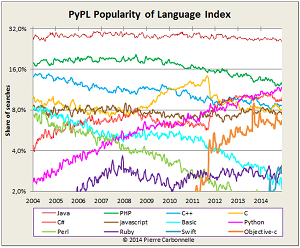News
JavaScript, Swift Grab Programming Language of the Year Rankings
- By David Ramel
- January 8, 2015
Ubiquitous JavaScript and newcomer Swift garnered 2014 programming language of the year honors from respective ranking organizations.
The top designations are based on increased popularity or interest rather than total usage by the TIOBE Index, which anointed JavaScript, and the PopularitY of Programming Language Index (PYPL), which crowned Swift.
Last year, TIOBE tagged Transact-SQL as the year's top mover, while the PYPL ranked Python as No. 1 in increased popularity percentage. The two indices use different methods to gather their data.
Overall popularity or interest was:
TIOBE Index:
- C
- Java
- Objective-C
- C++
- C#
- PHP
- JavaScript
- Python
- Perl
- PL/SQL
PYPL:
- Java
- PHP
- Python
- C#
- C++
- C
- JavaScript
- Objective-C
- Swift
- Ruby
However, by climbing from No. 9 last year to No. 7 this year on the TIOBE scale, JavaScript was named the new No. 1.
"JavaScript has won the award because it appeared to be the biggest mover of 2014," TIOBE said. "JavaScript won 1.70 percent in one year's time, followed by PL/SQL (1.38 percent) and Perl (1.33 percent). The JavaScript programming language has a long history and is always considered as the 'ugly duckling' from a language design point of view. Nevertheless, JavaScript has become the standard browser language through the years. Boosted by the successes of JavaScript libraries and frameworks JQuery, Bootstrap, Node.js and GWT, JavaScript really deserves this award."
On the PYPL site, meanwhile, owner Pierre Carbonnelle named Apple's brand-new Swift as language of the year based on a 3.9 percent 12-month trend, despite debuting as No. 9 in overall popularity.
The biggest losers on the TIOBE Index were Transact-SQL, which fell 0.68 percent, and Visual Basic .NET, which dropped 0.48 percent.
Here's the latest TIOBE chart of long-term trends:
 [Click on image for larger view.]
Long-term trends on the TIOBE Index (source: tiobe.com)
[Click on image for larger view.]
Long-term trends on the TIOBE Index (source: tiobe.com)
On the PYPL, the biggest percentage drop came at the expense of PHP, though it held its position as No. 2 overall. Visual Basic suffered the biggest drop, from No. 9 to No. 11.
Here's the latest PYPL chart of long-term trends:
 [Click on image for larger view.]
Long-term trends on the PYPL Index (source: PopularitY of Programming Language index)
[Click on image for larger view.]
Long-term trends on the PYPL Index (source: PopularitY of Programming Language index)
Carbonnelle said a possible interpretation of the latest PYPL data is:
- Java and JavaScript are fairly stable.
- Which language is taking advantage of PHP's decline? Possibly Objective-C.
- Objective-C was probably miscounted as C in 2009-2011, then took a life of its own.
- C# also had a curious dance with C in that period.
- The growth of C# comes at the expense of C++ and Basic.
- The growth of Python comes at the expense of Perl.
- Ruby and Rails grew quickly, then stabilized.
Because the two organizations use different means to measure popularity, direct comparisons are impossible. Each, however, professes to serve as a guide as to which language to use for a new development project.
For TIOBE, "The ratings are based on the number of skilled engineers worldwide, courses and third-party vendors," the site says. "Popular search engines such as Google, Bing, Yahoo!, Wikipedia, Amazon, YouTube and Baidu are used to calculate the ratings. It is important to note that the TIOBE index is not about the best programming language or the language in which most lines of code have been written.
"The index can be used to check whether your programming skills are still up to date or to make a strategic decision about what programming language should be adopted when starting to build a new software system."
PYPL, meanwhile, says the index "is created by analyzing how often language tutorials are searched on Google: the more a specific language tutorial is searched, the more popular the language is assumed to be. It is a leading indicator. The raw data comes from Google Trends, so that anyone can verify it, or make the analysis for his own country or other languages.
"If you believe in collective wisdom, the PYPL index can help you decide which language to study, or which one to use in a new software project."
About the Author
David Ramel is an editor and writer at Converge 360.